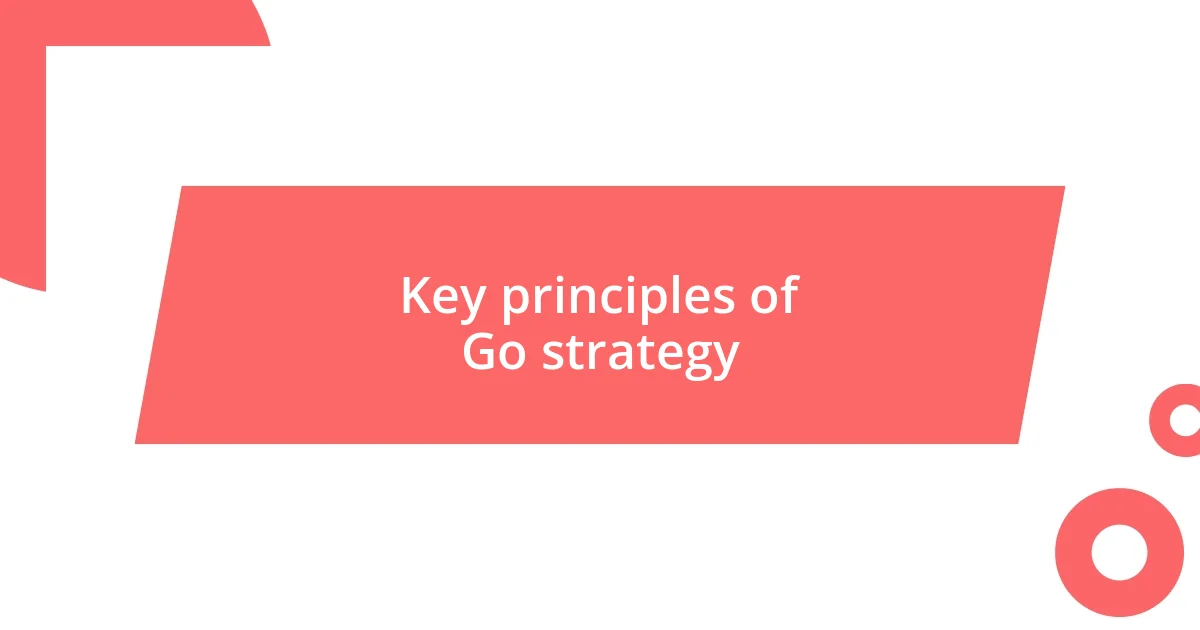Key takeaways:
- The author’s initial fascination with Go evolved into a passion through hands-on experiences and strategy development, highlighting the game’s depth and complexity.
- Engagement with online resources and local clubs facilitated significant growth, providing valuable insights, community support, and opportunities for personal connection.
- Participation in tournaments fostered resilience and adaptability, enriching the author’s strategic understanding while emphasizing the importance of diverse perspectives within the Go community.

My introduction to Go
My journey into the world of Go began quite unexpectedly during a casual conversation with a friend who was absolutely enamored with its intricacies. As they enthusiastically described its unique blend of strategy and simplicity, I couldn’t help but feel intrigued. I just had to find out what all the hype was about.
When I first sat down to play, I remember glancing at the board, which looked deceptively simple with its black and white stones. It felt like staring at a blank canvas, ready to be filled with creativity. How could such a basic setup lead to endless possibilities? That initial confusion quickly transformed into excitement as I began to explore tactics, realizing how much depth the game truly offered.
I recall my first victory, though it was hard-fought and required countless blunders to achieve. That win wasn’t just about the score; it felt like a real breakthrough, a testament to my perseverance. Have you ever experienced that thrilling rush of overcoming something that once felt insurmountable? For me, that moment was the spark that ignited my passion for Go, driving me to dive deeper into its captivating world.

Understanding the basics of Go
Understanding the fundamentals of Go is like peeling back layers of an onion. It’s not just about the rules; it’s also about the mindset. In many ways, I found that learning Go shifted my perspective on strategy and patience. Each move requires careful consideration, reminiscent of life choices where every decision can lead to vastly different outcomes.
One of the first things I learned was the concept of “territory.” Unlike other games that focus solely on capturing pieces, Go is about controlling the board. This shifted my approach entirely. I remember a moment during my early games when I let my eagerness to attack overshadow my need to secure territory. The result? A sudden defeat that taught me the importance of balance between offense and defense.
When it comes to the components of the game, the stones and the board offer a simple yet profound foundation. Each game, I discovered, was not just a contest of skill but also a reflection of my thoughts and feelings in that moment. There’s an elegance in how these basic elements come together to create a world of depth and engagement. Have you ever noticed how a game can mirror your mental state? I certainly have, and that connection is what keeps drawing me back to Go.
| Aspect | Description |
|---|---|
| Objective | Control the most territory on the board by strategically placing stones. |
| Play Area | A 19×19 grid board provides a vast space for tactics and strategy. |
| Stones | Black and white stones symbolize players, each move impacting the flow of the game. |

Key principles of Go strategy
One of the key principles I’ve embraced in my Go journey is the importance of “balance.” In Go, it’s vital to harmonize aggression with caution. I recall a match where I aggressively pursued my opponent’s stones, but my opponent skillfully built their territory, rendering my efforts futile. That game left me reflecting on how crucial it is to maintain a strategic equilibrium. Each time I try to press my advantage, I remember that moment, and it reminds me to consider the broader picture.
- Connection to Opponent: Understanding your opponent’s intentions can guide your choices.
- Shape: Creating efficient formations of stones is essential, as it maximizes your control and minimizes vulnerabilities.
- Life and Death: Knowing when a group of stones is alive (secure) or dead (captured) is crucial for effective play.
- End Game: Players must secure their territory as the game progresses, ensuring they maximize points while preventing their opponent from doing the same.
One principle that often resonates with me during gameplay is “flexibility.” Adaptability is crucial. I learned this lesson the hard way when I stubbornly stuck to my opening strategy even when my opponent’s moves clearly disrupted it. I remember feeling trapped, realizing that rigidity in approach could cost me valuable territory. Instead of forcing a plan, I now remind myself to be fluid, adjusting my strategies when needed. Flexibility isn’t just a principle; it’s become a vital part of how I navigate both the game and my life.

Learning through online Go resources
When I first dipped my toes into online Go resources, I was overwhelmed by the sheer volume of options available. From interactive tutorials to YouTube channels dedicated to gameplay analysis, there’s a treasure trove of knowledge just waiting to be explored. I remember stumbling across a particular website that offered lessons tailored to beginners, and it felt like someone had lit a bulb in my brain. Have you ever experienced that moment of clarity when a complex concept finally clicks? That was me, eager to absorb every lesson and apply it to my games.
One of my favorite online resources turned out to be a community forum where seasoned players shared their insights and experiences. It’s incredible how people’s stories can illuminate your own path, isn’t it? I distinctly recall joining in on discussions about specific moves and strategies that had puzzled me. The responses I received were not just practical tips; they were like little life lessons wrapped in Go wisdom. Engaging with more experienced players opened my eyes to alternatives I hadn’t considered before – I often found myself thinking, “Why didn’t I see it that way?”
As I dove deeper into the digital realm, I discovered a variety of games available for practice. There’s something wonderfully immersive about playing against others online. One evening, I challenged a player from halfway across the world, and while I lost, that match was a game-changer. I realized that every defeat is an opportunity for growth. Reflecting on that experience, it’s clear: these online platforms do more than teach the rules; they cultivate resilience and curiosity in every player.

Practicing Go with local clubs
I’ve found that practicing Go with local clubs has dramatically enriched my experience. The first time I walked into a club, I felt a mix of excitement and nerves. Everyone was intensely focused, and I wondered if I’d be out of my depth. But as I settled in, I realized that local clubs are welcoming spaces for players of all levels. The camaraderie is palpable; sharing strategies and discussing games over a cup of tea feels like being part of a family united by a shared passion.
Engaging in face-to-face games offers a level of connection that online play simply can’t replicate. I remember one particular session where I played against a seasoned opponent who took the time to explain his moves after our match. His insights were like windows into advanced strategies, illuminating concepts I had only read about online. Isn’t it remarkable how playing in person allows for immediate feedback and spontaneous learning? Those conversations are often the highlight of my club visits.
I’ve also noticed that the local scene sparks healthy competition. There’s something exhilarating about playing someone whose skills rival your own. I often leave the club feeling invigorated, eager to put into practice the new ideas I’ve gathered. Have you ever felt that rush after a challenging match? It’s a reminder that every game is a lesson—a chance to grow and rethink your approach. Joining local clubs has not just improved my gameplay; it’s fostered a sense of belonging in the Go community.

Participating in Go tournaments
Participating in Go tournaments is an experience unlike any other. I vividly recall my first tournament; walking into the venue, I felt a rush of excitement mixed with anxiety. The atmosphere was charged with passion, and it struck me how each player, regardless of their skill level, radiated determination. Have you ever felt that electric energy when surrounded by others who share your passion? It was contagious and made me eager to take part, even though I knew the competition would be fierce.
As I settled into my first match, the focus quickly shifted from nerves to strategy. I remember my hands trembling slightly as I placed my first stone. Each move felt monumental, the weight of the game resting on my shoulders. Reflecting on that initial tournament, I realized it wasn’t just about winning; it was an opportunity to push my limits and truly test myself. I still remember the moment I defeated a player whose skills I greatly admired. That victory ignited a fire within me, proving that growth often comes from stepping outside my comfort zone.
What I’ve learned through tournaments is the beauty of diverse perspectives. I’ve met players from various backgrounds, each bringing unique strategies to the table. After one match, I had an intriguing conversation with a fellow contender about the balance between offense and defense. Isn’t it fascinating how different minds can interpret the same game so differently? Those discussions lingered in my thoughts long after the tournament ended, enriching my understanding of Go and deepening my appreciation for the community I was entering.

Reflecting on my Go journey
Reflecting on my Go journey, I can’t help but marvel at how much I’ve grown since I first picked up the game. I still remember sitting in my living room, staring at the board, feeling overwhelmed by the sheer number of possibilities. Have you ever felt paralyzed by choice? It was only through consistent practice and a willingness to learn from my mistakes that I began to unravel the complexities of Go. Each loss, though painful, became a stepping stone toward greater understanding, instilling in me a sense of resilience.
As I think back on those early days, the thrill of discovering new strategies stands out. There was a pivotal moment when I stumbled upon the concept of “sente”—the idea of maintaining the initiative in a game. Suddenly, the board transformed into a canvas, and each stone I placed felt like a brushstroke in a masterpiece. Didn’t you ever feel that moment when everything clicks? The excitement was palpable, and I found myself eagerly experimenting with this newfound perspective in subsequent games, which added depth to my approach.
Another significant aspect of my journey has been the connections I’ve made along the way. I recall a rainy afternoon when I sat down with a fellow Go enthusiast at a café after a long day. We chatted about our trials and triumphs with the game, sharing not just strategies but also our personal stories. Isn’t it amazing how a game can foster such genuine connections? Those moments reminded me that Go is more than just stones on a board; it’s a bridge to community and shared experiences that enrich our lives.














